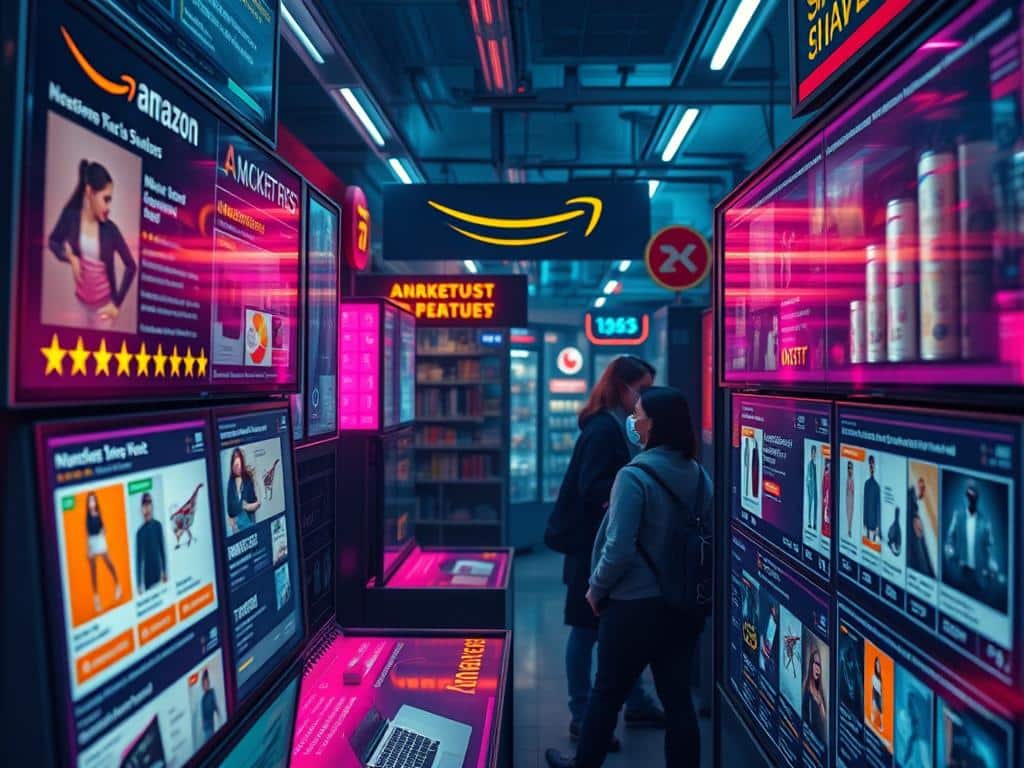With the rise of online shopping preferences, platforms like Amazon.com have become crucial hubs for product searches, attracting nearly 3 out of 4 consumers. Given this vast audience, sellers and brands have strategically leveraged Amazon’s advertising tools to capture buyer interest effectively. In 2023, Amazon’s advertising revenue is projected to surpass $39 billion, highlighting its dominance in the digital marketing strategy for e-commerce.
Despite a 38% increase in online advertising costs, particularly concerning Amazon ad spend, sellers can still achieve profitable pay-per-click (PPC) campaigns by adopting informed pricing approaches and developing robust ad strategies. By understanding and utilizing various PPC ad types such as Sponsored Products, Sponsored Brands, and Sponsored Display, sellers can ensure their products stand out and attract more customers.
The Importance of Amazon’s Advertising Strategy
Amazon’s advertising strategy holds immense significance in driving seller and brand visibility within an online marketplace where a majority of consumers begin their product searches. With the company achieving a valuation of 1.7 trillion dollars in 2021, it’s clear that Amazon’s marketing prowess plays a pivotal role in its business success. Operating in more than 200 countries, Amazon’s advertising approach ensures its products and services reach a global audience, enhancing online market engagement.
As competition intensifies, understanding and deploying effective advertising techniques become indispensable. Sellers are increasingly migrating from focusing solely on Sponsored Products to a broader strategy that includes Sponsored Brands and Sponsored Display ads. These approaches boost not only product visibility but also elevate brand presence within the marketplace. For instance, Amazon Sponsored Products can increase sales momentum and secure top search positions by targeting specific keywords, showcasing the effectiveness of Amazon PPC in driving results.
Amazon leverages various channels to maximize the impact of its advertising strategy. With over 10 million followers on Facebook in India and 2.8 million followers on Instagram, Amazon utilizes these platforms to share company news and advertising content. The company’s significant presence on Twitter, with two million followers, is also crucial for engaging users and drawing in new customers. Amazon’s YouTube advertising strategy, with a focus on attention-grabbing content, further exemplifies how the brand maintains high levels of online market engagement.
Additionally, Amazon’s advertising strategy encompasses a range of pricing tactics. Through promotional and behavioral pricing strategies, Amazon adjusts its pricing dynamically to stay competitive. The platform’s cost-per-click model ensures that advertising spend is aligned with actual customer engagement, enhancing overall cost-efficiency. This model is particularly beneficial for new sellers, who are incentivized with $50 in free clicks to facilitate easy onboarding, ensuring broader brand visibility from the outset.
Furthermore, Amazon Sponsored Display Ads and Amazon DSP (Demand Side Platform) offer advertisers the ability to target relevant customers both on and off the platform. By leveraging Amazon’s data intelligence, these ads optimize for maximum conversions and improved brand awareness, adding an extra layer of effectiveness to the overall advertising approach. Despite the average return on ad spend experiencing a decline year over year, the considerable ROI presented by Amazon’s ad products continues to attract significant investment from advertisers.
Types of Amazon Ads
Identifying and leveraging the appropriate types of Amazon ads is crucial for enhancing Amazon product visibility. Understanding the different advertising options available can help you maximize your budget and achieve your campaign goals. Here, we break down the primary ad types offered by Amazon.
Sponsored Product Ads
Among Amazon PPC campaigns, Sponsored Product Ads are the most prevalent. These ads integrate seamlessly with search results, appearing at the top, middle, and bottom of product listing pages. They blend in with organic listings but are clearly marked as sponsored, helping to attract and convert shoppers effectively. The minimum daily budget for these campaigns is $1, with costs influenced by bidding on relevant keywords. For more details, visit the WebFX guide on Amazon Advertising.

Sponsored Brands
Sponsored Brand ads are designed to increase brand visibility and allow sellers to showcase a selection of products through headline banners. These ads primarily capitalize on generalized keyword searches, providing an opportunity to promote brand name across various locations on Amazon. Sponsored Brands require a minimum daily budget of $1, and the advertising cost is determined by competitive keyword bidding.
Sponsored Display
Sponsored Display Ads focus on consumer interest rather than specific keywords. These ads extend their reach beyond Amazon and appear on third-party sites, increasing user engagement. This type of ad is less about keyword targeting and more about capturing the audience’s attention based on browsing behavior.
Premium Ads
Premium Ads offer a more visually striking advertising approach, similar to traditional visual banners and sidebar ads. Engaging with Amazon’s Premium Ads typically requires a larger budget and involves interacting with an Amazon account executive. This managed-service option usually demands a minimum spend of $50,000, making it more suitable for brands with substantial advertising budgets.
Self-Serve Ads
Self-Serve Ads on Amazon function much like Google search ads and empower sellers to have direct control over their campaigns. These ads allow for hands-on management, providing flexibility and control over your PPC campaigns. By effectively utilizing the bidding system and optimizing keywords, businesses can enhance their Amazon product visibility.
Understanding these different types of Amazon ads allows you to strategize better and optimize your advertising spend efficiently. Whether you are focusing on Amazon PPC campaigns or aiming to amplify your brand through Sponsored Brand ads, selecting the right type of ad is essential for achieving your marketing objectives on Amazon.
Costs Associated with Amazon Ads
Understanding the costs associated with Amazon ads is crucial for businesses aiming to maximize their advertising budget effectively. Various factors contribute to these costs, from the type of ads chosen to the competitiveness of the keywords. Effective management of your CPC strategy and online advertising costs can result in significant benefits for your business.
Cost Per Click (CPC)
The predominant cost model for Amazon ads is Cost Per Click (CPC). Advertisers bid on relevant keywords, and the winning bids determine how much they pay per click. The average CPC for Sponsored Products ranges from £0.20 to £3.00, while Sponsored Brands typically see costs between £0.10 and £2.00. The variability in CPC underscores the importance of a well-planned CPC strategy to manage online advertising costs.
Factors Influencing Ad Costs
Several factors influence Amazon advertising costs, including keyword competition, product category competitiveness, and the overall quality of the ads. Consistently monitoring and adjusting bids based on ad performance is vital. High-quality ad copy and images boost click-through rates, potentially lowering costs by enhancing ad effectiveness. Additionally, long-tail keywords can offer lower costs and higher ROI, proving to be a valuable CPC strategy for many advertisers.
Average CPC for Amazon Advertisers
On average, Amazon advertisers face CPCs of around $0.81, though this figure can vary widely. Factors like ad type selection, daily budget decisions, and keyword bids significantly impact advertising expenses. Optimal keyword selection and strategic bidding can help maintain cost-effective campaigns. Small businesses might spend between $9,000 and $15,000 per month on Amazon marketing, while midsize companies may allocate $15,000 to $35,000, and enterprise businesses could spend anywhere from $35,000 to $60,000 monthly.
How to Estimate Your Amazon Advertising Budget
Estimating an effective Amazon advertising budget is a critical aspect of budget management for PPC. This involves understanding your campaign’s goals, profitability, and engaging in effective keyword bidding strategies. Here’s how to get started:
Setting A Daily Budget
When you start Amazon ad campaign planning, setting a daily budget is paramount. Initial budgets can range from as low as $5 to $10 per day. However, to collect substantial data and make informed decisions on your keyword targeting and bidding adjustments, starting with a budget of $50 to $100 daily is more advisable. Key metrics to monitor include Advertising Cost of Sales (ACoS) and Return on Ad Spend (RoAS), which help in refining your budget allocation.
- Low budget: $5 – $10 per day
- Recommended starting budget: $50 – $100 per day
- Adjustment metrics: ACoS and RoAS
Keyword Bidding Strategies
Effective keyword bidding is essential to your Amazon ad campaign planning. Keywords can vary widely in cost, with exact bid costs for competitive products reaching up to $7.50 per click, while less competitive items may cost between $0.25 to $0.35 per click. Testing competitive bids, observing Amazon’s recommended bids, and adjusting accordingly can help optimize your campaign. Regular monitoring and tweaks ensure you stay within your allocated budget while maximizing your ROI.
Here’s a comparative look at estimated bid costs:
| Product Type | Estimated Bid Cost per Click |
|---|---|
| Highly Competitive | $7.50 |
| Less Competitive | $0.25 – $0.35 |
By carefully managing your daily budget and employing effective keyword bidding strategies, you can enhance your Amazon ad campaign planning, leading to more optimized and profitable PPC outcomes.
Return On Ad Spend (RoAS) for Amazon Ads
Understanding Return on Ad Spend (RoAS) is crucial for anyone looking to delve into effective Amazon advertising. This metric serves as a cornerstone for RoAS optimization, allowing you to evaluate the performance and efficiency of your ad campaigns.
The average RoAS for Amazon ads hovers around 4, but it varies significantly across different ad types and strategies. For instance, Sponsored Products ads yield a RoAS of 3.67, making them a favorable choice for many. Sponsored Brands ads come in second, while Sponsored Display ads typically yield the lowest RoAS. Close match targeting is shown to result in the highest RoAS, particularly for products priced under $20, indicating an increasing yearly return.
Products in the $21-$30 price range are considered the sweet spot for profitable ad campaigns due to their balanced RoAS performance. To ensure profitability, a minimum RoAS of 3x is essential. In some industries, such as Consumer Electronics, RoAS can go as high as 9x, whereas it averages around 4.5x in the Toys and Games category.
Optimizing your ad spend includes setting the right bid amounts, which can be achieved by multiplying the average order value by the conversion rate and dividing by the target RoAS. Analyzing search term conversion helps isolate high-performing keywords, thus aiding in precise bid management. Moreover, AI-driven budget efficiency ratings can be leveraged to ensure daily budgets are maximized, facilitating incremental sales opportunities.
While RoAS is a vital metric, it’s also essential to consider Customer Lifetime Value (CLV) to gauge the true profitability of your ads. A comprehensive evaluation of search term value and competition can help set realistic RoAS and ACoS goals. Ultimately, focusing on the right keywords and optimizing page content will not only increase lead conversion but also decrease overall ad spend, enhancing Amazon advertising ROI.
How Much Does Amazon Pay For Advertising
Amazon digital advertising has become a core component of their business strategy, driving substantial revenue growth. The company projects that ad revenue projections will exceed $39 billion in 2023, underscoring the massive scale at which Amazon is operating within this competitive ad market.

Projected Advertising Revenue
Amazon’s projected advertising revenue highlights the company’s dominance in the digital ad space. With daily impressions averaging approximately 81,666,333, the platform provides an immense opportunity for sellers. The average Cost Per Click (CPC) stands at $0.99, with fluctuations such as $0.82 in February and $1.14 in July, reflecting the dynamic nature of advertising costs. Amazon’s average Click Through Rate (CTR) is 0.34%, which, though modest, translates to significant engagement given the volume of impressions.
The conversion rate on Amazon is notably higher than general eCommerce benchmarks, sitting at 9.96% compared to 1.33% on other sites. This significant difference underscores the platform’s effectiveness at converting advertising investment into sales. In terms of Advertising Cost of Sales (ACOS), sellers can expect an average around 29%, though this can range from 25% to 36% depending on various factors.
Impact of Competition on Ad Costs
The intensifying competitive ad market plays a significant role in influencing Amazon’s ad costs. With around 2,975 new sellers joining daily in 2021, the competitive landscape is ever-growing. This surge means higher CPCs due to increased bidding for optimal ad placements. Advertisers need to strategically leverage long-tail keywords, often comprising three or more words, which attract less competition and higher purchase intent, translating to lower costs and enhanced ROI.
Niche-specific metrics can provide deeper insights for advertisers, enabling them to benchmark performance against similar sellers. Understanding these nuanced elements is crucial for optimizing advertising spend and achieving a commanding presence within the market.
| Metric | Value |
|---|---|
| Average CPC | $0.99 |
| Average CTR | 0.34% |
| Average Conversion Rate | 9.96% |
| Daily Impressions | 81,666,333 |
| Average ACOS | 29% |
Conclusion
Surmounting the challenges of advertising cost management on Amazon demands strategic planning, keen market analysis, and responsive ad adjustments. With Amazon’s advertising costs ranging from $0.10 to $6.00 per click, understanding the variety and costs of self-serve and premium ads is essential. Aligning these with your brand goals is pivotal in maximizing Amazon ads.
The factors influencing Amazon PPC costs are multifaceted, including competition within the product category, click-through rates, and the chosen bidding strategy. Effective advertising cost management requires a solid grasp on these elements and optimizing your Return on Ad Spend (RoAS). Thus, continually refining your targeting efforts and being adaptive to market shifts are crucial steps in harnessing the full potential of your investment.
Amazon’s ad space is becoming increasingly competitive, making it imperative to balance bid strategies with budget considerations. Sellers must prioritize a proper organization of ad structures, cost-effective keyword targeting, and the inclusion of negative keywords to optimize their campaigns. Employing strategies like automatic and manual bidding can also simplify the process while offering control over ad spend for experienced sellers.
Ultimately, the complexity of advertising on Amazon underscores the importance of informed, adaptive strategies in strategic digital advertising. By doing so, you can manage costs effectively and achieve outstanding outcomes. Optimizing your Amazon ads and embracing these best practices can propel your ventures toward greater visibility and profitability in this expansive, competitive marketplace.
FAQ
How much does Amazon spend on advertising?
What is the importance of Amazon’s advertising strategy?
What types of Amazon ads are available?
How are the costs associated with Amazon ads determined?
FAQ
How much does Amazon spend on advertising?
Amazon’s advertising revenue is projected to exceed billion in 2023, reflecting the growing investment in digital marketing strategies by the company. Sellers and brands on Amazon are increasingly utilizing these advertising tools to capture buyer interest.
What is the importance of Amazon’s advertising strategy?
Amazon’s advertising strategy plays a vital role in ensuring brand and product visibility in an online marketplace where a majority of consumers start their product searches. Effective use of Amazon PPC (pay-per-click) campaigns can significantly enhance your online market engagement and brand visibility.
What types of Amazon ads are available?
Amazon offers a variety of ads:
– Sponsored Product Ads: These are the most prevalent, seamlessly integrating with search results to enhance product visibility.
– Sponsored Brands: These ads showcase a selection of products through headline banners, ideal for more generalized keyword searches.
– Sponsored Display: These ads focus on consumer interest, extending reach beyond Amazon to third-party sites.
– Premium Ads: These require a larger budget and interact with Amazon via a sales representative.
– Self-Serve Ads: These provide a hands-on campaign management experience similar to Google search ads.
How are the costs associated with Amazon ads determined?
The costs of Amazon ads predominantly operate on a Cost Per Click (CPC) basis, with the average CPC across advertisers being approximately
FAQ
How much does Amazon spend on advertising?
Amazon’s advertising revenue is projected to exceed $39 billion in 2023, reflecting the growing investment in digital marketing strategies by the company. Sellers and brands on Amazon are increasingly utilizing these advertising tools to capture buyer interest.
What is the importance of Amazon’s advertising strategy?
Amazon’s advertising strategy plays a vital role in ensuring brand and product visibility in an online marketplace where a majority of consumers start their product searches. Effective use of Amazon PPC (pay-per-click) campaigns can significantly enhance your online market engagement and brand visibility.
What types of Amazon ads are available?
Amazon offers a variety of ads:
– Sponsored Product Ads: These are the most prevalent, seamlessly integrating with search results to enhance product visibility.
– Sponsored Brands: These ads showcase a selection of products through headline banners, ideal for more generalized keyword searches.
– Sponsored Display: These ads focus on consumer interest, extending reach beyond Amazon to third-party sites.
– Premium Ads: These require a larger budget and interact with Amazon via a sales representative.
– Self-Serve Ads: These provide a hands-on campaign management experience similar to Google search ads.
How are the costs associated with Amazon ads determined?
The costs of Amazon ads predominantly operate on a Cost Per Click (CPC) basis, with the average CPC across advertisers being approximately $0.81. Factors influencing these costs include ad type selection, daily budget decisions, targeting types, and bids per keyword.
How can I estimate my Amazon advertising budget?
Estimating your Amazon advertising budget involves setting a daily budget and establishing keyword bidding strategies. Starting budgets can range from $5 to $10 a day, with recommendations suggesting $50 to $100 daily for substantial data collection and informed decision-making. Effective keyword bidding management is crucial for a successful campaign.
What is Return On Ad Spend (RoAS) and why is it important for Amazon ads?
Return On Ad Spend (RoAS) measures the efficiency and profitability of your Amazon ad campaigns. It helps evaluate how effectively your investments are driving revenue. Optimizing RoAS ensures that your ad campaigns are profitable and aligned with your branding goals.
How does competition impact Amazon’s ad costs?
Increasing competition among sellers and brands on Amazon drives up CPC rates, necessitating strategic advertising investments. Sellers must leverage in-depth market insights, competitive analysis, and responsive tactics to maintain a competitive edge and manage their ad costs effectively.
.81. Factors influencing these costs include ad type selection, daily budget decisions, targeting types, and bids per keyword.
How can I estimate my Amazon advertising budget?
Estimating your Amazon advertising budget involves setting a daily budget and establishing keyword bidding strategies. Starting budgets can range from to a day, with recommendations suggesting to 0 daily for substantial data collection and informed decision-making. Effective keyword bidding management is crucial for a successful campaign.
What is Return On Ad Spend (RoAS) and why is it important for Amazon ads?
Return On Ad Spend (RoAS) measures the efficiency and profitability of your Amazon ad campaigns. It helps evaluate how effectively your investments are driving revenue. Optimizing RoAS ensures that your ad campaigns are profitable and aligned with your branding goals.
How does competition impact Amazon’s ad costs?
Increasing competition among sellers and brands on Amazon drives up CPC rates, necessitating strategic advertising investments. Sellers must leverage in-depth market insights, competitive analysis, and responsive tactics to maintain a competitive edge and manage their ad costs effectively.








